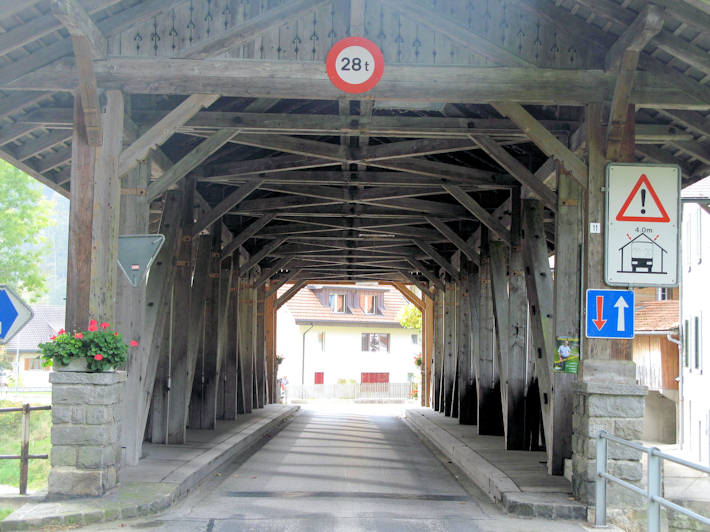cbdeck_kmeyerusteri
Switzerland, 01/18/2010
Hi Joe
It is now more than a month you sent me VCBS Bridger Winter 2009. Thank you!
I studied with interest the article out of the journal of the Ohio Historic
Bridge Association under
"Covered Bridge Fiction or Fact - What is a covered bridge? Addressing the Vexing
Questions of Authenticity." Most of the arguments I can follow but in Switzerland
and also in Europe the rating of covered bridges seems to be different.
For small traffic and pedestrians in rural
areas today timber bridges are popular but the deck construction is "waterproof"
and the trusses are protected mostly by metal. So glue-laminated timber bridges
are often not covered by a roof as the bridge in "Kemmeribodenbad" in the Emmental,
where the Keatings have been, and of which I sent you some pictures.
I realise that in US preservation of covered
bridges is even financed by federal funds. That happens in Switzerland only for
very special objects and in special cases. In the last years we did not get federal
aid in my "former county", even they invested much more than a million $ but in
the Aare-bridge of Wangen, of which I sent you an article some years ago. [See
http://www.vermontbridges.com/kapellbruecke_by_meyer-usteri.htm]
I studied the Covered Bridge Manual
of the Federal Highway Administration [April 2005- Pub # FHWA-HRT-04-098] and I think it is an excellent
help for all who have to deal with covered bridges. Such a manual I have not yet
found from a European country. I just wondered about the bridge-deck construction.
Most of the damage of our covered bridges is due to the water carried in by tired
vehicles on rainy days or in winter. Water flows down through planks and beams and
finally the timber loses its strength. So we built in covered bridge decks made
of glued laminated boards in vertical position often pressed together with horizontal
steel rods.
In a Norwegian paper I found a notice on the
same problem. Here is a link for you:
http://www.balticroads.org/conference25/files/kleppe-o2.pdf
I think it extremely interesting as
it seems you [in the U.S.] have not that problem; I did not find our modern bridge deck construction
in the mentioned Covered Bridge Manual, where they write "you are permitted using advanced
technologies".
I send you three photos of a covered bridge in Trubschachen (Emmental, Berne) called
"Oele-Brücke" built 1892 - span 82ft. - height 13ft 6 in. - width 15ft 8
in.- bearing capacity 28 europ.tons or 31 US tons.
The bridge deck consists of one piece of gluelam, vertical boards
prestressed by steel rods. There is an insulation on the wood and on top a
bituminous coating 3 to 4 in. as it is used for roads. Th sides are made
tight, so no water from the tires can drop to the wood construction. - Yours in bridging, Konrad Meyer-Usteri
 |
WGN CH-06-67 Photos by Konrad Meyer-Usteri |
 |
WGN CH-06-67 |
 |
WGN CH-06-67 |
 Joe Nelson, P.O Box 267, Jericho, VT 05465-0267
This file posted 02/02/2010
Joe Nelson, P.O Box 267, Jericho, VT 05465-0267
This file posted 02/02/2010
 Return to Front Page
Return to Front Page